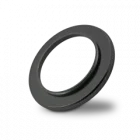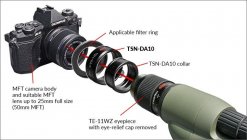Steve it would be very helpful if you would tell us what you intend to do with the image files.
However, to try to be helpful let’s start with the basic concepts.
Eyepiece Projection - using the spotter with its lens and the camera without a lens the adapter locates the camera image sensor at the eye point/eye relief position of the spotter lens.
Digiscoping - using the lenses of both the spotter and camera the adapters locate the camera image sensor at the back focus of the camera lens. Note that this normally requires the internal focal plane of camera lens to be at the eye point/eye relief position of the spotter lens which limits camera lens selection or ability to achieve focus.
Books have been written about both techniques but the question of which is preferable is dependent on how the images obtained are intended to be used.
I’m going to make some popcorn and wait for the experts to chime in.
I will use it for spotting shots for myself at 1 mile.
A few months ago I got an urge to shoot at a gong of ~ 2 MOA at a mile. I kinda hoped the urge would subside, but it has not. LOL
I do not expect to have someone to sport for me.
I have most of the parts to build an ELR rifle except a barrel which I had to order. Still working on the freebore so I can order the reamer, but there is time for that. I do have a 6mm barrel and a 6 BR AI reamer to shoot at 1,000 yards to have some fun and sort things out while I am waiting on Kreiger to make a barrel for me.
I have found a few things. With no lens on the DLSR you have to physically move the camera in and out to achieve the best focus. If you have a lens you use the focus ring of the lens.
I think, in both configurations, the eyepiece of the spotting scope is retained.
The DSLR lens does have a magnifying effect but I am not sure how much or how to calculate it. I did see the calculations but I'm not sure where I saw it. I'll have to find it again.
Yesterday I found some software to use a DSLR as a webcam to get the live video from the DSLR to a tablet or laptop. I think I can use VLC or something like it to record shots so I can review them if the splash is hard to see.
Why not cellphone? The sensor on a cellphone is in the 5mm X 5mm range. The sensor on my DSLR is 35mmX 24MM. 33 times more sensor area. The 'magnification' of a cell phone is done be simply looking at a smaller area of the sensor. Unlike optical magnification there is no additional image present, it is not actually magnification. Then there is the superior quality of the sensor and the Expeed processing which a cell phone does not have. Plus, the quality of the lens (In this case, Nikon.) on a DSLR is orders of magnitude better in sharpness, distortion (or rather lack of distortion), image accuracy and light transmissivity.
Here is a lens + eyepiece configuration.













